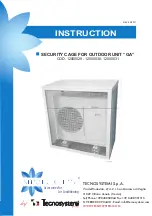
JOHNSON CONTROLS
16
FORM100.50-EG12 (918)
ECONOMIZER
The economizer section is used to maintain indoor air quality, and also to reduce energy
consumption by using outdoor air cooling in lieu of mechanical cooling. If outdoor air is
appropriate for cooling, but not sufficient for the cooling demand, mechanical cooling will
stage on as necessary until the cooling load is met.
Dual (comparative or differential) enthalpy operation is the most accurate and efficient
means of economizer operation. The IPU controller monitors the return and outside air
energy content, and selects the lower of the two for operation.
VAV SUPPLY AIR PRESSURE CONTROL
Traditional packaged single package unit systems use inlet guide vanes (IGVs) for duct
static pressure control. These control supply duct pressure by modulating dampers (in-
troducing losses and inefficiencies) on the inlet of the fan, open and closed. Johnson
Controls variable frequency drives (VFDs) offer superior fan speed control and quieter,
energy efficient operation.
FIGURE 2 -
TRADITIONAL OVERHEAD VAV AIR DELIVERY SYSTEM
For VAV applications, the Johnson Controls Series 100
unit uses a VFD to modulate fan
speed and maintain a constant duct static pressure. VFDs offer superior control over the
operation of the unit at part load, and offer the additional benefits of quieter and more ef
-
ficient operation when compared to IGV.
FLEXSYS
™
The traditional approach to HVAC design in commercial buildings has been to supply
conditioned air through extensive overhead duct networks to an array of diffusers spaced
evenly in the ceiling. In Figure 1, the conditioned air is both supplied and returned at ceil-
ing level. Ceiling plenums must be designed large enough to accommodate the supply
ducts that run through them. Return air is typically configured as ceiling plenum return
without any ductwork. This type of air distribution, known as the “well-mixed” type, is the
most common system in use. This conventional HVAC system is designed to promote
complete mixing of supply air with room air, thereby maintaining the entire volume of all air
in the space (from floor to ceiling) at the desired space setpoint temperature. In addition,
to meet IAQ requirements, an adequate supply of fresh outside air must be introduced to
this mix. A key disadvantage to this control strategy is that it has no provisions to accom-
modate different temperature preferences among the building occupants or to provide
preferential ventilation in the occupied zone.
Application Data (Cont'd)
Содержание YPAL070
Страница 4: ...JOHNSON CONTROLS 4 THIS PAGE INTENTIONALLY LEFT BLANK FORM100 50 EG12 918 ...
Страница 73: ...73 JOHNSON CONTROLS FORM 100 50 EG12 918 Field Control Wiring Figure 9 FIELD CONTROL WIRING ld08184 ...
Страница 74: ...JOHNSON CONTROLS 74 FORM100 50 EG12 918 Figure 10 FIELD CONTROL WIRING Field Control Wiring Cont d ...
















































